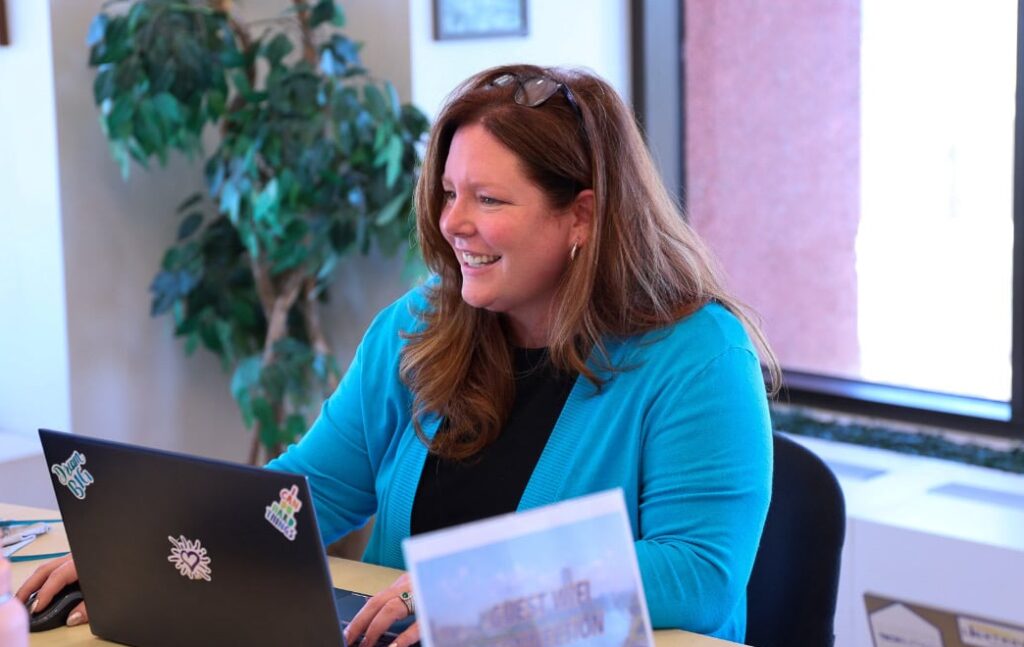In today’s talent-squeezed recruitment landscape, finding and hiring the people you need for your organization can be incredibly challenging. At its worst, the process is time-consuming, frustrating, and costly.
By taking a few simple steps to streamline your hiring process, you can gain a competitive advantage – one that allows you to attract and hire higher quality talent, in less time.
In this article, we’ll discuss how adopting smart strategies helps you optimize the recruit-to-hire process. Quickly identify the right-fit talent, and hire the best people faster and with more confidence than ever before.
Make speed to hire your advantage in the never-ending competition for top talent.
Here’s where to start…
Establish a Target Date When You Want the Future Employee to Start Work
[Day 0 | Task Time: <30 minutes]
As we know, the hiring process ends with the candidate starting their first day of work. But that’s where you’ll begin.
“Begin with the end in mind.” This is the second of the 7 Habits of Highly Effective People, by Dr. Stephen R. Covey.
This is a key: Establish the potential employee’s first day of work – your hiring process end date – and create a schedule of actions to be completed by that date.
Very few companies do this, including your competitors. And this is an opportunity you can capture – one that can help you hire faster, and better. Define a date, and move forward by planning backwards.
You can now build your hiring schedule, beginning with the day you want this new employee to start, and schedule the tasks and actions that need to be completed to hit that date.
If you think about this from the perspective of setting SMART goals, you have a hiring timeline that’s specific, measurable, relevant, and time-bound. It’s important to make sure this is achievable too! Make sure all stakeholders involved in this process have the time and are willing to commit to this timeline.
Once your target date has been chosen, these are the next actions you’ll want to schedule.
Document Your Hiring Needs
[Day 0 | Task Time: <1 Hour]
As you start the journey of expanding your team, it’s crucial to identify your work needs for the position you intend to hire for.
Document the skills and experiences needed for someone to do the job.
This should be less focused on the number of years of experience, and more on the experience itself.
Know this: A calendar does not indicate skill level. Some people with two years’ experience are more skilled than those who have 10 years of experience.
Work ethic combined with years of experience is a much better indicator of skill. And you can screen for work ethic.
Also, Consider factors such as cultural fit to ensure a smooth integration into your team dynamics. You’re answering the question, what kind of a person do you want to work alongside of you? And what do they need to know how to do?
Your company’s core values should be your guide here. Schedule an hour to list out your specific hiring needs.
Create a Modern Job Description
[Day 0 | Task Time: <2 Hours]
A job description (JD) is one of the most important parts of the recruitment process, and most companies get it wrong.
The job description provides potential applicants with the information they need to make an informed decision about whether the role is right for them to apply to.
In addition, a JD is an important piece of HR documentation for the employer. Check out this overview of job descriptions from the Society for Human Resource Management (SHRM):
“A job description is a useful, plain-language tool that explains the tasks, duties, function and responsibilities of a position. It details who performs a specific type of work, how that work is to be completed, and the frequency and the purpose of the work as it relates to the organization’s mission and goals. Job descriptions are used for a variety of reasons, such as determining salary levels, conducting performance reviews, clarifying missions, establishing titles and pay grades, and creating reasonable accommodation controls, and as a tool for recruiting. Job descriptions are useful in career planning, offering training exercises and establishing legal requirements for compliance purposes. A job description gives an employee a clear and concise resource to be used as a guide for job performance. Likewise, a supervisor can use a job description as a measuring tool to ensure that the employee is meeting job expectations.”
It’s important to note, that one of the key pieces of a JD as indicated above is the layout of job expectations. This is so the company and employee can get in clear agreement on what is required from someone in the position. This can be a critical piece of documentation in the event there is an HR-related issue later.
So, there’s a lot to be included in a job description if it’s to be both a resource of information for potential job applicants and an HR tool for employers and hiring managers.
But there’s another wrinkle: Studies tell us most people don’t read websites. They scan them.
And most job descriptions are viewed online, via a job board, where employers are hoping to land quality applicants for their open position.
As such, your job description should include all the above-mentioned points, but also be easy to scan through.
So, here are your three steps to crafting an effective modern job description:
- Step 1: Include your list of hiring needs.
- Step 2: Include all the appropriate descriptions of functions, responsibilities, and requirements of the position, as referenced by SHRM.
- Step: 3: Format all this information in a way that’s easy to scan through for quick understanding.
Bringing in the list of hiring needs, pairing it with a documented list of job functions and expectations, and re-crafting that info into a bulleted, easy-to-scan modern job description will take some focused time. We suggest carving out two hours of well-intentioned time to design this modern job description, so you can use it as a template for each additional JD and save time in the future.
Once you’ve created a modern job description, you’re ready for the next step.
Promote the Position
[Day 1 | Task Time: 48-72 Hours]
In today’s competitive job market, it’s important to promote your company’s open job positions effectively. Here are three ways to do just that:
First, encourage your employees to refer qualified candidates for the position. This should be one of the first levers you pull to source quality potential candidates for your open role. Find your best, most loyal employees, and look to their network of friends and acquaintances. Offering referral bonuses for successful hires can be a great incentive, but the idea of working with your friends is motivating enough for many. And people often complain about their jobs to their friends – a perfect time to introduce the prospect of your open position.
Second, harness the power of digital communications and social media to reach a wider audience. Craft engaging social media posts about the open position, and then share your posts and job openings on your company’s LinkedIn, Facebook, or other social media pages. Wherever candidates you’re interested in working with spend their time, that’s where you should be.
But then go a step further and provide your employees with a posting that they can share to their social networks. Could you craft a message team members can use to send to their contacts to create deeper and more targeted awareness about the job? If people love working for you, you’ll find they’ll be more than happy to help spread the word of your open job with their contacts.
Third, consider posting your job listings on specialized job search websites. Job search websites like Indeed can certainly help gain applicants for an open role, but are there other job boards specific for your industry, your city, or this type of position? Identifying and posting to these job boards will increase your odds of connecting with a more targeted audience of active job seekers.
Each of these are important steps to take to identify potential candidates for the role. The goal here is to perform these steps with speed so you maintain your momentum.
For more generic positions you’re looking to have a collection of applicants within 48-72 hours. For more niche roles, you may need to expand the timeframe and give yourself a little more grace as it may take longer to get candidates.
Review Applications & Resumes and Schedule Interviews
[Day 4-5 | Task Time: 24 Hours]
In today’s job market, it is more critical than ever to review job applications and resumes promptly. Taking too long to review applications and resumes can lead to losing top candidates to competitors – a costly mistake.
Not only does swift action here demonstrate your enthusiasm and respect for potential employees, but it also signals that you are a responsive and efficient employer. Scheduling interviews quickly is equally important in showing that you value the candidate’s interest in your company and their employability.
Technology can help you speed up this process too, with tools that can connect to your team’s calendar and allow candidates to quickly book an interview time.
In today’s competitive job market, talented individuals are in high demand and often have multiple job offers to consider. Failure to act quickly will not only cost you the best candidates, but more of your valuable time. A delayed hiring process can impact your company’s productivity and lead to a more prolonged recruitment cycle.
Remember, your goal is to get out of the recruitment cycle as fast as possible, but certainly by your predetermined first day from the start of this process! That way you make the hire you need to make and get back to performing the revenue-generating work that needs to be done.
You should be exiting the day you begin this step with interviews scheduled on the calendar, in the near future, for each of your remaining candidates in consideration.
Conduct Virtual Interviews
[Day 6-7 | Task Time: 48 Hours]
In today’s remote work environment, conducting virtual interviews has become the norm. But you’ll want to use them strategically.
Nearly every manager who has a history of interviewing has been trapped in an in-person interview with a candidate they knew wasn’t a fit for the job in the first five minutes of interviewing them. These situations are a waste of time for the interviewer and interviewee, who took the time out of their schedule for the interview and incurred the drive time.
Virtual interviews are a great option for first meetings with individuals who have not been referred by a trusted source, such as a long-time employee, team member, or trusted business advisor.
First, they save both the interviewer and interviewee time and money by eliminating the need for travel.
And second, virtual interviews allow for greater flexibility in scheduling and can accommodate candidates from different locations.
Conducting a first round of virtual interviews is a smart choice for first introductions between both employers and non-referred job seekers. And for speed to hire, you’ll want to conduct all your virtual interviews over a period of two days, so you can quickly move to the next step.
With that being said, if a candidate has been referred or recommended from a trusted source and you feel confident in their fit for the role, you can save time and skip to the next step.
Conduct In-Person Interviews
[Day 8-10 | Task Time: 72 Hours]
Interviewing styles can vary, and each style can have its successes. There is no one way to interview. But when it comes to hiring talent with speed, you’re looking to identify what you need within the interviewee as quickly as possible.
If you’re the only one interviewing the candidate, great. If you have multiple team members interviewing the candidate, which is a good best practice, then coordinate all these interviews to take place on the same day, in succession. Even better, group interviewers together, as each interview in this instance doesn’t need to be one-on-one.
Having crafted a hiring needs list and modern job description, you and your interviewing team should have a good understanding of what everyone is looking to learn in their interview time.
The main point here is to combine all your interviews into one successive series of interviews that take place on the same day, instead of conducting multiple interviews across multiple days, which expands the hiring timeline. Expanding the hiring timeline will only serve to increase the odds that you’ll lose a good candidate to a competitor company with a faster hiring process.
A three-day period (or less) in which all your remaining candidates interview is what you’re striving for. This limits the amount of time the first candidate, who may be your best candidate, is waiting to receive a job offer. The longer people wait in between steps, the more likely you are to lose them.
Make an Offer
[Day 10 | Task Time: <24 Hours after final interview]
When interviewing a candidate, the job of the interviewer is to come to one of two conclusions: “Hell Yes” or “No.”
When those are the only two options, you eliminate decision paralysis – which trips up many hiring managers as they fall past deadlines, costing the company good candidates, more time, and more money.
The best practice we recommend is to confer with your interviewing team right after each candidate interviews and identify if they are a “Hell Yes” or a “No.” That way, everyone is able to share feedback promptly and arrive at a decision. If at the end of all your interviews you have multiple “Hell Yes” candidates, that’s great! Pick one.
Then extend the job offer right away.
If you’re moving with speed, you are extending an offer to your top “Hell Yes” candidate within hours of your final interview.
And you could even make an offer onsite, at the conclusion of your interview, if you believe your last interviewed candidate to be the “Hell Yes” candidate you’d like to extend an offer to.
What Happens If You Don’t Identify a “Hell Yes” Candidate?
There are two potential pitfalls to watch out for when moving quickly in this process:
First, sometimes the timing is off and none of the candidates you interviewed qualify as a “Hell Yes.” This can happen. And if it does, you can certainly begin again at Day 1, armed with the information you learned from the first pass through the process.
Second, identify if one or more members of the interviewing team are looking for perfection. We discussed this earlier: perfection is your enemy. If a candidate is great, and has nine out of 10 skills, then hire them and move on. You can teach them that last skill.
Perfection doesn’t exist, and interviewers can be just as much of an obstruction to the hiring process as candidates can. Don’t let this be you.
Onboard Your “Hell Yes” Candidate
The timeline may vary a bit between a candidate accepting an offer and them starting their first day of work. Some candidates may be able to start work right away while others may need to provide two weeks or more of notice to their current employer and take some time.
Then during the onboarding process, there can be background check information, drug testing, or other compliance information that needs to be processed.
Ensure you’ve done your part to build speed into the onboarding process for the tasks that you can control, while upholding your responsibilities as an employer. A background check is important, so don’t skip. But an incoming employee waiting days on health insurance paperwork because it’s on your HR manager’s long to-do list is not okay.
Technology can help you improve the candidate experience even in onboarding too! Could you integrate tools into your process that replace physical paperwork with digital files and signatures?
Your goal is to make this stage as seamless as possible and make sure your new hire focuses on how excited they are to start work with your company! Candidates can still be lost during the onboarding process, even after they’ve accepted your offer. Don’t let sloppy or slow onboarding trip you up.
Find the Talented Professionals You Need Quickly
Establishing a hiring timeline is a smart way to identify and hire great employees quickly. It involves building a list of hiring needs, crafting a modern job description, conducting virtual interviews for non-referred candidates, and grouping interviews on the same day for final candidates, all on a schedule that promotes urgency.
You started with the end in mind. Hit that planned employee start date!
In so doing, you will increase your odds of saving the company time and money, reduce the odds of losing potential recruits to competitors, and establish an expectation of preparation and performance for new hires.
Institute a hiring timeline for your hiring process and put yourself on the path to success with your next hire.
And if you’re looking for a hiring partner that can help you find the technology talent you need at the right time? We can help with that! Learn more here about how our Lighthouse technology staffing team can help your business grow through contract, contract-to-hire, or direct hire staffing.





